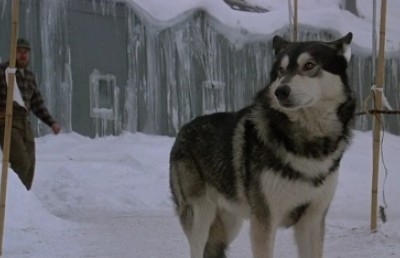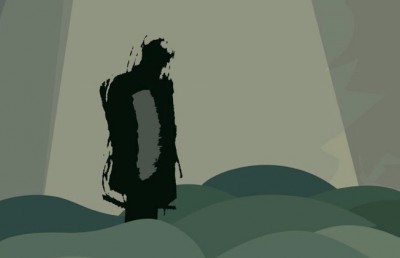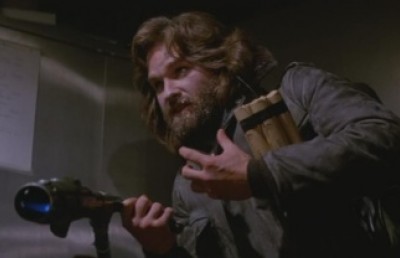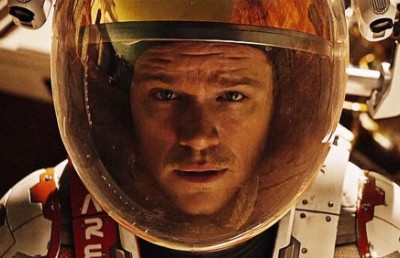The Passion of the Zone (Pt. 1)
Ecological Shortsightedness and the Limits of Auditory Extension in Andrei Tarkovsky’s Stalker
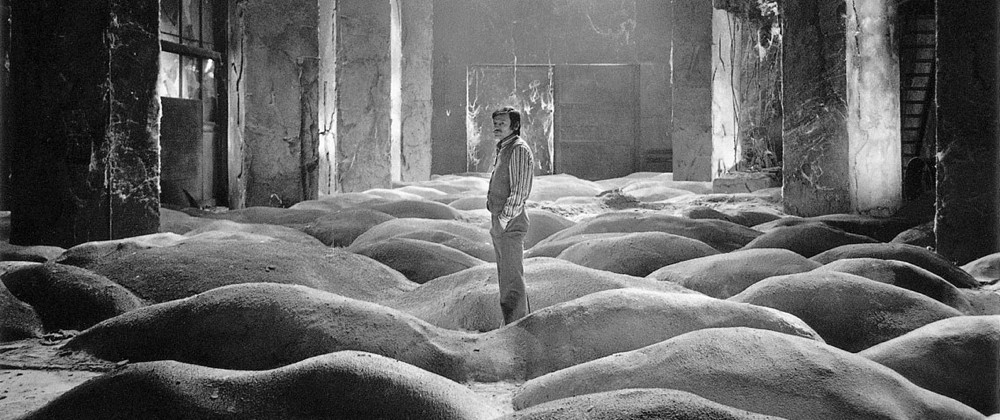
Let everything that has been planned come true. Let them believe. And let them have a laugh at their passions. Because what they call passion actually is not some emotional energy, but just the friction between their souls and the outside world. And most important, let them believe in themselves, let them be helpless like children, because weakness is a great thing, and strength is nothing. - Stalker
Introduction 1
In Andrei Tarkovsky’s Stalker (1979), there is an instance of voice-over narration mid-way through the film that describes “passion” as the friction created between our deepest internal level – the soul – and the world external to the body that houses this soul. This concept of passion provides the basis for the film’s fundamental narrative theme of ecology: the result of contact between the innermost desires of human beings and the reality of the world in which they live. Passion, as defined here, becomes an ecological issue, for it posits the point of connection between inside and outside as a space of tension that has to be negotiated. This negotiation is the issue that drives the narrative forward.
Three men, referred to simply as Stalker (Anatoli Solonitsyn), Writer (Aleksandr Kaidanovsky) and Professor (Nikolai Grinko), travel to a desolate post-apocalyptic area known as the “Zone,” hoping to reach the mythical “Room” in which, it is said, one’s deepest desires can be made manifest. The three men arrive at the threshold of the Room and there they suffer an existential crisis; none of them decides to enter, fearing that the true nature of their darkest souls will be revealed to the world with terrible consequences. Here the division between interior and exterior space is set up as the line between the human soul and the objective reality of the external world. In this scenario, the men themselves act as mediators of their own relationship to the world. They must decide whether or not to engage their passions, to establish a free flow from their inner souls to the world in which they live. In so doing, they discover their own self-mediation, which plays out in the space we see on screen by their refusal to cross the threshold of the room. The architecture of the bunker that houses the Room provides the physical structure of spatial division between the men and their intended destination, but this structure is only a prompt that allows the men to come to terms with what is really at stake: the division between their inner selves and the world outside.
The film can be read as a metaphor for the benefits of ecological containment: a nuclear power plant must keep its contents contained, lest a breach create the kind of disaster seen at Chernobyl in 1986, an event eerily foreshadowed in Tarkovsky’s film released seven years prior. The permanently contaminated site of the Chernobyl meltdown is now cordoned off and has been labeled “The Zone of Absolute Exclusion.” There is no specifically nuclear event presented in Stalker’s narrative; instead, the Zone is vaguely positioned as the result of a possible extra-terrestrial visitation, but it can clearly be read as a cold-war commentary on the dangers of the nuclear age. The Zone consists of a constantly shifting geography, a supernatural space that requires an expert – a stalker – to navigate successfully. The visibility of a large power plant in Stalker’s town, and the fact that his daughter suffers a genetic mutation, lend credence to the idea that the unstable properties of the nearby Zone are connected to heavy industrialization in some way, perhaps the result of a toxic breach of containment subsequently roped off and covered up by the government with fantastical stories of alien visitation.
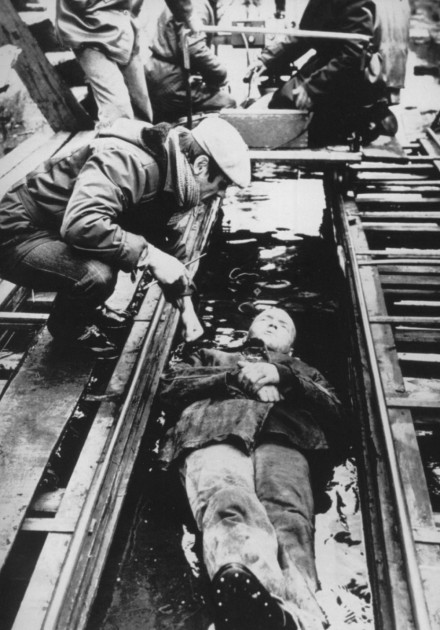
Indeed, it has been suggested that the profound weight of the film’s allusions to the environmental dangers of nuclear waste played out quite tragically in the lives of Tarkovsky and his cast and crew, many of whom died of cancer in the years following the Stalker shoot that took place on locations drenched in contaminated water from a nearby factory (Martin 2005, 159). Could it be that watching these men slog through the foamy and visibly polluted waters of the Zone is to watch them contract the seeds of the cancer that would eventually kill them off, a documentary subtext that is detectable only upon paratextual hindsight? Though the facts of Tarkovsky’s death and its relationship to the film’s shooting locations are not part of the text of Stalker itself and will thus not figure into my reading of the film, these facts nevertheless weigh heavily on what the film does present us with: an existential investigation of the very concepts of ecological balance between people and their environments. The reality of toxic waste is that of a troubled relationship between the internal workings of a factory or power plant and the world that surrounds it outside. A nuclear meltdown is a breach of containment, but the film’s climax on the threshold of the Room presents an ambiguous stance. Whether we’re talking about nuclear waste or the darkness of men’s souls, the question is this: is it better to keep dangerous elements contained within their housings, maintaining a clear separation between inside and outside that runs the risk of disastrous breach? Or, is it better to aim for a situation in which free flow between inside and outside is acknowledged as a reality, and create systems for being in the world in which such flow is not a danger to the environment or the organisms that live within it?
The three men opt for containment, recognizing that they are not living lives that are conducive to a free flow between their innermost desires and the world outside. Stalker’s daughter (Natasha Abramova), on the other hand, demonstrates a remarkable openness to the world through powers of telekinesis revealed in the film’s final shot. Upon returning from the Zone, Stalker meets up with his wife (Alisa Frejndlikh) and daughter and they walk home, power plant looming large in the background. Stalker’s daughter sits in the kitchen where she appears able to move three glasses across the table with the power of her directed visual attention. She has bridged the divide between interior and exterior space. Yet again, the film reserves judgment on this openness. Is she a mutant who threatens humanity? Or does she represent the next phase of human evolution wherein we become more at one with our environments through an openness that dissolves the boundary between self and the world?
Under Soviet rule, allegory and subtext were regular tools for artists wanting to address pertinent issues without directly implicating the government. Surely as the filmmakers slogged through waist-deep pools of toxic sludge they had issues of environmental containment on their minds. Yet Tarkovsky has famously resisted the idea that his films are in any way symbolic for things not depicted within them (Christie 1981, 161), and I generally respect this attitude. So my interpretation of the film will not be in search of nuclear holocaust as subtext for the film’s direct address of the problems of human experience. I will deal with what Tarkovsky puts in front of us. In fact, as I will demonstrate, the idea of taking the world as it is directly observable is the operating principle of the Zone and its cinematic representation. Regardless of what the narrative tells us about the source of the Zone’s unusual properties, the film makes clear that these properties do not work in accordance with the way that human beings usually experience their environments. Further, Stalker’s exposure to this unusual environment has resulted in the genetic mutation suffered by his daughter. Whether allegory for the environmental dangers of nuclear technology or not, the narrative gives us enough to warrant a reading of the film based on themes of ecology.
I will demonstrate that the film’s narrative emphasis on the divide between the soul and the external world is conveyed by its approach to audiovisual synchronization. The unstable spatial properties attributed to the Zone are created by three basic approaches to sound/image relationships: the use of ambiguous sound; an unstable approach to offscreen sound; and most importantly, a heavy emphasis on sounds that are attached to concrete sources within the diegesis only when these sources are made visible on the screen. These three elements create a space in which the only coherent cause/effect relationships between sound and image are grounded in direct connection between a sound and its implied visual source on the screen. All sounds that can be labeled asynchronous, offscreen, or acousmatic reflect the peculiar qualities of the Zone: an unstable environment in which anything out of view is constantly shifting and unreliable. These qualities of the Zone stand in stark contrast to the very deliberate stability of the world outside the Zone, where offscreen sounds are unambiguous and directly attributable to concrete sources that are connected to the world on screen. Thus the sound of an offscreen train early in the film is tied to vibrating objects in Stalker’s bedroom; in the Zone, on the other hand, the sound of a nearby thundering waterfall becomes audible only when it is revealed on screen. 2
Tarkovsky’s sonic treatments outside the Zone correspond with R. Murray Schafer’s concept of the “hi-fi soundscape”: one in which we can hear far into the distance, and in which what we hear in the distance is always contextualized in terms of its source (1977, 43). This is an unbroken relationship between the near and the far that Schafer suggests is absent in the “lo-fi” environment he associates with the constant noise of the modern city. The space of the Zone disrupts this hi-fi soundscape, presenting a kind of lo-fi environment where people are cut-off from their surroundings by the audiovisual equivalent of shortsightedness, seemingly aligning with Schafer’s oft-critiqued bias for the hi-fi situation he associates with rural and wilderness environments as opposed to their urban “opposites”. However, the Zone is not the kind of urban environment in which Schafer’s notion of the lo-fi soundscape usually exists; it is a desolate rural area, one in which distant vistas are often present, as well as sounds that appear to stem from far away. It is the unstable qualities of these distant sounds that cut them off from the world that exists immediately around the characters who venture into the Zone, creating a variation on Schafer’s schizophonia where sound behaves counter-intuitively yet without the technologies of sound transmission that Schafer associates this kind of situation.
Though Schafer’s construction is replete with ideological problems (see Sterne 2013), as a figure of thought it is evocative of so many imaginary situations that arise in the cinema, particularly within the modes of fantasy and science fiction that inform Tarkovsky’s work in Stalker. The Zone presents a paradox when approached by way of the notions of “hi-fi” and “lo-fi” soundscapes, and this paradox is what makes the space of the Zone so unusual: it should be a hi-fi environment, but its soundscape exhibits schizophonic qualities consistent with a lo-fi situation. The combination of the hypercontextualization of the very near and the instability of the very far creates a kind of inverse schizophonia in which disorientation emerges because sounds are too closely connected to their sources rather than too disconnected. I argue that the Zone can be understood as a cinematic metaphor for environmental shortsightedness, trusting only what is directly around one despite being able to see and hear very far into the distance. This is tied to the main theme of the film: the careful control of the relationship between the human soul and the world outside of the body. The film’s approach to audiovisual ecology thus establishes its themes as a function of its sound design.
I will demonstrate how the approach to sound/image relationships in the Zone is ultimately a reflexive move that is tied to the film’s approach to camera movement: the camera is frequently positioned as a diegetic presence in the film capable of bringing the world into being through the direction of its attention. I argue that this is a similar position to the one occupied by Stalker’s daughter at the end of the film: a character that has learned to affect the world through directed attention. In so doing, she also bridges the gaps between sensory modalities; vision becomes touch, and her powers can be read as the development of transsensorial awareness that transcends the boundaries of the individual sense modalities. Thus the daughter also transcends the boundary between the soul and the external world, projecting her inner consciousness to the world outside, bringing it into motion. Notions of auditory “fidelity” in Stalker can be traced according to the line that reaches through the boundary that keeps internal experience from opening up into the external world. In this case, I argue that the film keeps this boundary line intact, a less “faithful” relationship between the experience of its characters and the external world in which they live.
Where her father and his two clients failed to open themselves up to the world in the heart of the Zone, Stalker’s daughter embodies such openness and, perhaps, the next phase of human evolution. The film withholds judgment about the daughter’s position, leaving the audience to decide whether she is the result of inhuman mutation or whether she points in the direction of progress for humankind. Either way, she embodies the main ecological theme of the film that can be tied to the way its audiovisual ecology plays out across the space of the Zone and the world outside its borders. The relationships between camera movement and sound that I will discuss are thus formal markers of the narrative weight embodied by Stalker’s daughter at the end of the film.
Stylistic Considerations
Stalker uses a carefully strategized approach to the representation of audiovisual space as a reflexive approach designed to call attention to the relationship between sound and space. I begin my analysis with a comparison/contrast between the beginning and ending of the film, and then suggest how we can understand the changes brought about in the film’s final shot by paying close attention to what takes place between these two points. Stalker begins by positing a world with very precise connection between the world on screen and its extension into offscreen auditory space. By the end of the film, questions arise about this relationship, and this change is brought about by the heart of the film: the journey into the supernaturally unstable space of the Zone. I argue that the characters in Stalker undergo a shift in their environmental awareness by way of the shifting space of the Zone and the architecture of its ruined buildings: they move from the stable space of their town to the unstable geography of the Zone, and emerge to a world in which the properties of the Zone have leaked back into the world outside through the figure of Stalker’s daughter. Their journey ends with the decision to remain closed off from the world around them, an anti-ecological position. Stalker’s daughter thus remains an anomaly, an ambiguous figure whose powers set her apart from the other people in her world.
Before progressing any further into my argument, it will be useful to identify some of Tarkovsky’s stylistic characteristics in order to better situate the specifics of his work in Stalker within a sense of his body of work as a whole. One of the main things that authors note about Tarkovsky’s general style is the use of long takes, often associated with a kind of Bazinian ideal in which the viewers are responsible for their own reading of the film with minimal guidance by way of directed attention. At the same time, Tarkovsky’s camera is almost always in motion. Vlada Petric talks about Tarkovsky’s interest in “insistent, continuous camera movement through space instead of controlling the viewer’s attention by cutting from one image to the other…directly opposed to the Eisensteinian collision produced by the juxtaposition of stationary shots” (1989/90, 121). When Tarkovsky does direct our attention, it happens almost imperceptibly. Tarkvosky’s camera often moves so slowly that the motion is barely visible, allowing the time for viewers to “engage in their own reflection upon what they perceive on the screen” (122). It is often only through comparing the framing at the beginning and ending of any given shot that we may realize just how much the camera has actually moved. This is a stylistic strategy that Donato Totaro links to processes of minimalist music in which the evolution of a piece is noticeable as a kind of afterthought, not during the experience of the evolution itself (2001, 251). This feeling of slowness is aided by the fact that there is often very little figure movement within the mise-en-scène of any given shot, concentrating instead on a density of texture rather than multiple layers of action that require a long take in order for them to play out.
In Bazinian terms, the use of the long take with an emphasis on depth of field is admirable for its realist qualities, an antidote to the continuously directed attention of mainstream cinema’s emphasis on coverage through montage (1971, 25). Yet Tarkovsky’s work is not specifically realist in its aims, and his use of the long take often works against the development of a concrete and stable world. In fact, a particular quality of his work is the oneiric aesthetic of many of his shots, established in part by the use of long takes with very slow movement that drift through spaces of minimal action.
Many commentators have also discussed the feeling of simultaneous co-existence of different planes of reality within the seemingly grounded paradigm of Tarkovsky’s long take aesthetic. Midway through Tarkovsky’s career, Ivor Montagu writes, “Stylistically he intermixes in his presentation the straight story – events in sequence – with events that happened in the past or may happen in the future, or can never happen, all represented on the same plane of actuality, without any of the fades or trick ‘effects’ that older techniques used to help guide the spectator to a distinction” (1973, 118). Vlada Petric adds that, “An important feature of Tarkovsky’s dream imagery is that his shots are never distorted from their representational appearance, yet at the same time the projected image looks “estranged” (1989/90, 122). He continues, “Tarkovsky’s oneiric vision rests on an interaction between the representational and the surreal: the viewer feels that something is ‘wrong’ with the way things appear on the screen, but is incapable of detecting sufficient ‘proof’ to discredit presented events on the basis of everyday logic. As a result, the shot is ‘estranged’” (125). Tarkovsky liberates the long take aesthetic from its frequent use by other filmmakers as a realist convention, and incorporates it into a style that seeks something of a more metaphysical nature.
For Donato Totaro, this metaphysical aspect can be found in what he calls “creation time” where “time is given the power of ‘creation,’ in the sense that something magical, unbelievable, or unexplainable (and often simple) occurs within the ‘reality’ (real time) of the continuous long take” (2001, 262). This is distinguished from what Totaro calls “drab time,” where the long take works more along the lines of realist ideals: revealing the concrete reality of three-dimensional space without any surprises to question the stability of this space (262). So while the use of the long take is consistent across the entire film, the function of the long take changes from the first section of the film to the second and third.
I agree with Totaro’s overall analysis of the film’s form: the world before they enter the Zone operates one way; the Zone operates another way: and then the Zone’s properties are brought back to the world outside in the film’s final section. However, my analysis of the audiovisual ecology of the film will necessitate a slightly different reading of many of the same shots that Totaro uses as his examples, for when we add sound to the equation new things are revealed that help us understand Tarkovsky’s long takes a little differently. One very important distinction between my reading and that proposed by Totaro is that the world outside the Zone remains consistent in terms of how sound is handled in relation to the image, with no auditory changes apparent after their journey to the Zone. What has changed in the film’s third section is the introduction of Stalker’s daughter as a character with powers that I argue are born within the Zone, but which stand in stark contrast to the world outside the Zone in which she lives. The film’s final long take does present the kind of revelation that is absent in the film’s first section, but this is a revelation about how the daughter interacts with the world, not about the operational principles of the world itself. Stalker’s daughter embodies the potential for a new way of being that has not been adopted by her father and his clients.
The audiovisual consistency that is apparent in the world outside the Zone is best illustrated in comparison to the way sound relates to image inside the Zone. n her article “And Then There Was Sound” (1992), Andrea Truppin suggests many ways in which the use of ambiguous sound helps create the feeling of estrangement that so many commentators have discussed. Truppin argues that “the use of ambiguous sound plunges the audience in to a never fully resolved struggle to believe in the diegesis, much as the films’ characters struggle with their own ability to have faith” (235). When paired with a long take aesthetic in which the space visible on the screen appears stable, the sound can add an instability that imbues the image with a sense of estrangement. This works especially well when the image presents a long take aesthetic consistent with Totaro’s drab time of the outside world: sound aids in imbuing drab time shots with a feeling of the creation time that Totaro observes in the visual realm elsewhere. As I will discuss, this is one of the ways in which Tarkovsky establishes the unnatural qualities of the Zone.
In focusing on these qualities of simultaneous realism and estrangement, these authors are describing the aesthetic effects of what Jim Leach refers to as the “crisis of representation” in Tarkovsky’s work: something that brings us into the realm of the fantastic “where natural explanations seem insufficient but cannot be ruled out” (1990, 212). Leach grounds his discussion of Tarkovsky’s crisis of representation by focusing on the idea of cinema as a medium inherently unstable in its inability to represent unified space. He says that Tarkovsky’s last film, The Sacrifice (1986), has the power “to investigate problems of illusion and representation which are central to the relationship between art and life (and the film will never quite allow us to forget that this problematic includes the apparatus and, by extension, ourselves as spectators)” (207). It is precisely on this point of dealing with the crisis of representation in the cinema, and the relationship between the cinematic apparatus and the audience, that Tarkovsky develops the concept of the Zone in Stalker. In particular, I argue that the film deals with the cinema’s difficulties in representing unified space through an audiovisual strategy that emphasizes the artificiality of sound/image relationships within the Zone. The constantly shifting geography within the Zone suggests the inadequacies in representing spatial continuity that have led to conventions of realism through montage on the levels of both sound and image. The Zone limits access to the world outside the direct attention of those who pass through it, and this supports the fact that cinematic representation can only ever provide limited access to the larger whole of the world that it posits but never fully reveals. The three men inside the Zone are positioned as though they are metaphors for cinemagoers confronted by the illusionist premises of realist convention that, through their active attention, comes apart at the seams. I argue that this positioning is a reflexive strategy designed to call attention to the artificiality of cinematic space, and the film constructs its audiovisual relationships to call attention to this artifice.
The style of sound in Stalker is quite particular in many ways, but also shares much in common with Tarkovsky’s entire oeuvre. Part of the sense of auditory estrangement in Tarkovsky’s work, particularly for North American audiences, is the generally artificial quality of the post-production sound work. Tarkovsky’s approach to Foley effects and voice dubbing creates a kind of hyperrealism where certain sounds are exaggerated while others are entirely absent, and the voice is always foregrounded with little in the way of any naturalistic approach to spatial signature. However, I think it would be a mistake to put too much emphasis on the artificiality of the Foley and dubbing work in the film. The sound quality of his films shares much with his contemporaries on that level, with many of the particular qualities of the Foley and dubbing simply a matter of common studio practice in the Soviet Union at the time. I suggest that this sort of artificiality is less a matter of intention for Tarkovsky, more a consequence of production context. My suggestion here is supported by the fact that the qualities of dubbing and sound effects in Stalker do not change much between the Zone and the world outside. What does change dramatically between these spaces is the sound editing and mixing, and the choices made in synchronizing sound with the image. My analyses will thus be based principally on techniques relating to these aspects of the sound design.
Given that all the sounds in the film seem somewhat artificial, we need to address which ones are operating according to realist principles of sound/image synchronization, and which are intended as part of the cause/effect ambiguity that permeates Tarkovsky’s work. As Truppin explores, Tarkovsky’s use of ambiguous offscreen sound often serves to call into question that which is seen on the screen; in Stalker, the reverse is often true: by using non-ambiguous sounds attached to sources we see on the screen, he calls into question everything that lies outside of the frame. This is a very unusual approach, and I argue that it exposes the cinema’s dual nature: instead of working to maintain the illusion of a stable diegesis, this hyper-contextualization of sound inside the Zone actually works to destabilize this peculiar geographical space.
Andrea Truppin suggests this kind of hypercontextualization of sound within the image is an exaggeration of the Hollywood convention “in which the microphone records only a narrow range of sound delineated by the camera’s visual field and very little offscreen sound is picked up beyond this field” (1992, 240). “In this convention,” says Truppin, “space does not exist until the camera creates it” (240). Interestingly, this observation contradicts Truppin’s larger thesis of the use of ambiguous sound across Tarkovsky’s work. The idea that the camera creates the space and brings its attendant sound into being is not a question of ambiguous sound. Rather, it is a situation in which sound is so unambiguous that it doesn’t even exist in the offscreen world. The presence of this strategy within the Zone does not fit with her general thesis about the proliferation of ambiguous sound across Tarkovsky’s work, a problem that she never fully resolves in her article. However, I suggest that this problem need not be resolved. Truppin’s thesis about Tarkovsky’s interest in ambiguous sound is correct. It’s just that the space of the Zone in Stalker needs to be recognized as quite unique in Tarkovsky’s work. While the Zone does contain examples of the ambiguous sound that Truppin has identified in all of Tarkovsky’s later films, it also features this hypercontextualization of sound that is designed for the particularities of the Zone, a space like no other space in Tarkovksy’s oeuvre. This quality of the Zone stands in stark contrast to the world outside. Let us now consider this distinction between worlds in detail.
The World Before the Zone
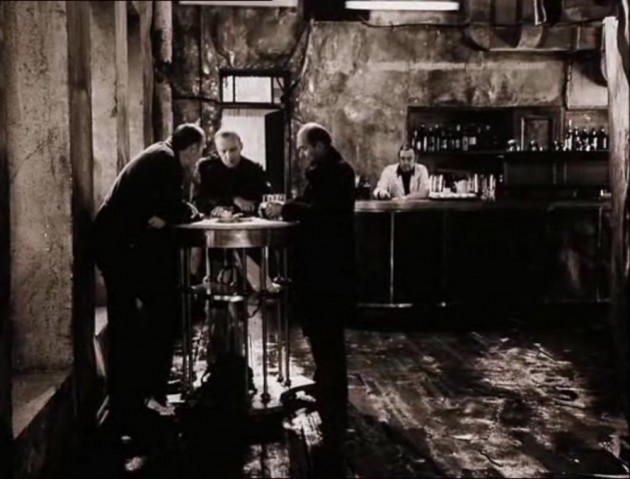
To provide a sense of the differences between the inside and outside of the Zone, I will begin by establishing how sound/image interactions function in the world outside the Zone prior to the journey of the three men. This is the stable world of Stalker’s home and town. The film begins with a single long take of the interior of a bar where Stalker will eventually meet up with his two clients, Writer and Professor. This shot is paired with the non-diegetic theme music by Edward Artemiev, an auditory situation that will recur several times throughout the film. In general, the recurrence of this theme at various points is one of the most conventional uses of sound within the film. It serves, as most film scores do, as tonal support for the mood of the film. More interesting aspects of the sound design lie in areas that are not so clearly identifiable as film score, yet which are orchestrated with just as much attention to detail as one would expect from a piece of music.
The opening shot at the bar is followed by a three shot sequence that sets up the space of Stalker’s house. We begin with a track from outside Stalker’s bedroom to the threshold, stopping at the doorway to peer in momentarily. Then there is a cut to a static close-up of their nightstand, eventually giving way to a lateral track across the bed showing first Stalker’s wife asleep, then their daughter asleep, then Stalker awake, and then a track right back to the night table. Cut to the third shot, back to the wide angle of the bedroom where we see the Stalker get out of bed, put on some clothes, and move out of the room.
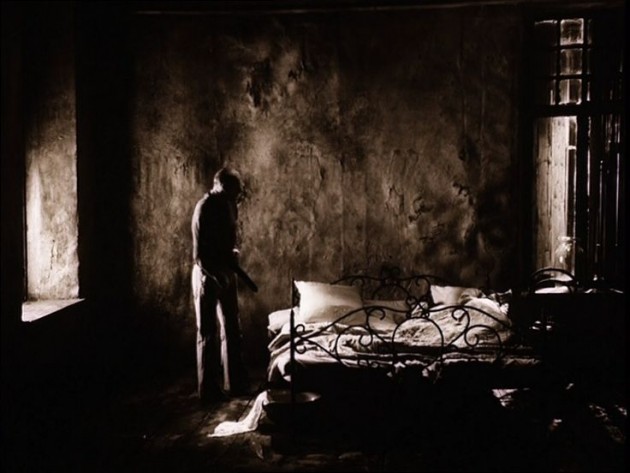
The very first thing we hear in this sequence is the sound of a distant train whistle, followed by the beginnings of the sound of the metal nightstand vibrating. The stand starts to vibrate more vigorously once we cut to the close-up, with a glass of water moving across its surface. As soon as the lateral track begins, we hear the sound of a train rushing by. A loud rendition of “La Marseillaise” fades in and out as though blasting from the passing train, and then the sound of the wheels on the tracks disappears once the camera track has stopped. After cutting back to the wide shot, we continue to hear sounds of the whistle in the distance, along with Stalker’s footsteps on the creaky floorboards as he moves about the room.
This opening sequence establishes some key points about the world in which the Stalker lives. First and foremost, there is a profound connection established between offscreen sound and the world that appears on the screen. Though our view is restricted to the confines of Stalker’s house, its walls do not impede our ability to hear far into the distance; the soundscape is presented in vast extension. Just as the sound vibrations of the train’s whistle can act on our eardrums, so do the vibrations of the train rolling by act on the furniture in the room. This is a solid world of cause and effect. Yet at the same time, this sequence sets up one of the film’s major operating principles: a tight relationship between camera movement and the sound of the space pictured on the screen. Timing the lateral tracking shot to the sound of the train’s wheels binds this sound to the camera’s movement through the space. Though we are not meant to understand that the train sounds are caused by the moving camera, their connection here foreshadows many instances in the Zone where similar tracking shots will bring the sound of the visualized space into being through the camera’s movement. Sometimes sounds are even attached to objects whose movement on screen is a function of the camera rather than the movement of the object itself, thus inverting the relationship between sound and movement to expose the presence of the camera. This is the beginning of a reflexive strategy that is more prominent within the Zone where the sound of visualized space is less about the space itself and more about the camera that creates it, an increasingly visible presence as the film progresses.
The sound of the train in the opening section establishes a concrete spatial environment in which offscreen sound is connected to the pro-filmic world in a way that will disappear inside the Zone. Importantly, the sound of the train also works thematically: it is the sound of the world outside the home that continually draws Stalker away from his family, much to his wife’s chagrin. After Stalker gets out of bed, she confronts him about leaving for the Zone again after he had promised not to, and asks him if he understands the effect of his absence on their daughter. He pays little attention, simply brushing his teeth before heading out the door, asking her to be quiet so as not wake up the little “monkey,” again acknowledging the cause/effect relationship between sound and the world pictured on screen. His wife then collapses in a fit of hysterical sobbing on the floor, and the sound of the train rushing by on the tracks emerges once again, rising in amplitude to match her rising despair. The sound of the train, eventually compounded with the sound of an airplane, is used as what Chion would call an “empathetic sound device” (1994, 8) to amplify the tension and drama of this scene, behaving the same way as a musical cue might in another film. But because of its referentiality, the sound of the train also foreshadows the train that will carry Stalker back into the Zone. Like associating the train with the vibrations of the nightstand, here the film ties it to the vibrations of the woman’s body. In this world, offscreen sound sets the interior of the house trembling both literally and symbolically. Finally, the scene ends with the continuing sound of the train acting as a bridge over a visual cut to Stalker at a nearby train yard next to the bar where he meets up with Writer. Though we don’t see the specific train that is supposed to be making the sound we hear, we do see other trains that establish the proximity of such sound makers to Stalker’s home.
The whole of the film’s first section is thus structured around Stalker and the train gradually coming together. Stalker’s town is clearly an industrial environment with most of the offscreen sound consisting of machine noise, along with the schizophonically presented music that emerges with the passing train. However, it is nevertheless a world in which there is a low signal to noise ratio with little difference between the inside and outside of Stalker’s house. Sound from outside has a tangible connection with what lay within, and the connection between what we can hear in the distance and what we see on the screen is very tight, keeping a sense of perspective that would be lost in a lo-fi situation. This hi-fi situation will change dramatically within the Zone.
Stalker continues to present a stable approach to auditory extension throughout the film’s first section leading up to the arrival of the three men in the Zone. Having met up with his two clients at the bar, the three men have a chat while waiting to begin their journey into the Zone. Writer and Professor discuss their mutual interest in the Zone, despite their divisions along the lines of art and science. Both, it seems, are interested in seeking the “truth” in their own way, and hope that their experience in the Zone will prove enlightening. Stalker suddenly looks out the window next to their table and then interrupts their conversation: “Do you hear it? Our train.” This is the film’s first direct engagement of what Chion calls “active offscreen sound”: a character in the film hears something with a source outside the visual field of the frame, and responds to it within the narrative (1994, 85). This is the next logical step towards Stalker’s movement away from his house to the train that will bring them into the Zone.
Offscreen sound continues to build a stable sense of the diegetic world as the three men drive their jeep through a military zone in order to meet their train. At one point they stop the car and listen. Hearing a motor, they duck down to hide from what they know is a police motorcycle patrolman, who then enters the frame thus concretizing the offscreen sound within the visual space on screen. This kind of visualization is profoundly absent in the film’s second section. Inside the Zone, visualized sound sources will emerge on the image and sound tracks simultaneously; non-visualized sound sources will remain out of sight. Overwhelmingly, the Zone tends not to present an offscreen sound and then reveal its implied source on the screen (though as with any rule there are important exceptions).
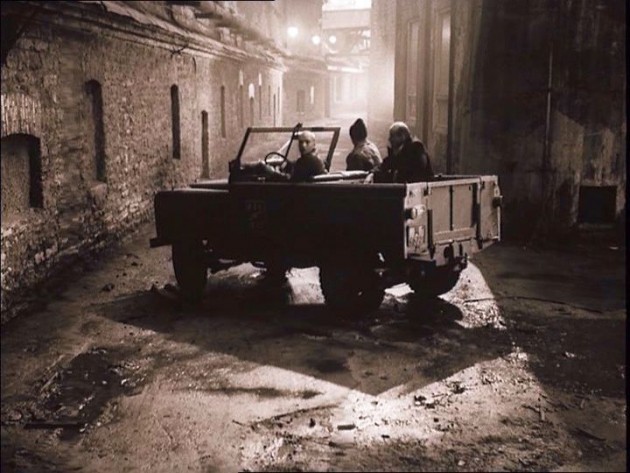
In the world outside the Zone, the film maintains a clear distinction between interior and exterior space through a stable approach to spatial signature, even while there is permeability between the inside and outside of the buildings we find here. For example, sounds inside the large industrial buildings through which the men travel on their way to meet the train are highly reverberant, while sounds in more open areas are not. There are hints at the sudden arrival of sound and source simultaneously that will become a trademark of the Zone: a train passes by the door of a building and we only hear its massive rumbling as soon as it is visible, even though it should have been audible before being seen on screen. Yet any examples of this that we can observe outside the Zone are not tied to issues of unstable geography within the narrative as they are within the Zone. Therefore, these examples work as kinds of foreshadowing, and to tie the presence of trains to the theme of travel into the heart of the Zone.
Ultimately, the function of the train is to act as a conduit between spaces, both literally and symbolically. Its distant sound binds the offscreen world to that which we see on the screen; it heralds Stalker’s flight from home and the trouble he leaves behind; and finally, the men commandeer a railway inspection car and use it to travel the rest of the distance into the Zone. The train thus threads the two spaces, joining the first and second parts of the film together. This journey on the inspection car is marked by the famous slip from representational sounds of the wheels on the track into a piece of electroacoustic music by Edward Artemiev that contains a similar metallic timbre and repetitive rhythm, but whose sounds are abstract with little indication as to their source. Through Edward Artemiev’s scoring we find an example of how offscreen sound turns into sound that might better be described as classically acousmatic: abstracting from source to something that we pay attention to in its own right, a parallel track. Yet the sounds are positioned within the narrative context of the train ride, and stem from the referential sounds of the car on the tracks. After the first shot of the men setting off, we don’t see the rail car at all until it has come to a halt. As the men ride, the camera remains focused on close-ups of their faces with the landscape passing in the background. This slip into spatial abstraction marks a journey into the highly ambiguous and unstable space of the Zone, an instability that is largely established by the sound design. The journey into the Zone is the last element establishing the theme of the train as an object that transcends spaces in the film: from outside to inside; from the town to the Zone; from the inside of the diegesis to the space outside; and as we’ll discover in the film’s final shot, between the internal experience of the characters in the film and the external world in which they live.
The World After the Zone
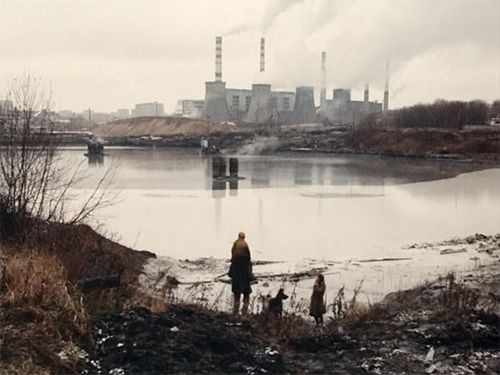
Once the men disembark from the railway inspection car in the Zone, Stalker sends it back down the rails from whence they came. After this we don’t hear any sounds associated with trains until the final moments in the Zone: the camera is positioned inside the Room looking out past the threshold at the three men as they sit, unwilling to enter. Cut to a close-up of the water pooling in the room, and the sound of a train rolling on the tracks emerges and forms a sound bridge over an elliptical cut that spans an untold amount of time, bringing us back to the bar in town where we find Stalker’s wife and daughter waiting for him. Here again the sound of the train works as a conduit between spaces. With our return to Stalker’s town we are back to the stable use of offscreen sound where what we hear in the distance once again finds grounding within the world, even when their sources are not visualized on the screen. Stalker and his family leave the bar and walk back towards their home, now accompanied by a black dog that Stalker has brought home with him from the Zone. The family is presented in a single long take that begins with a close-up on the daughter, then gradually shifts to a long shot revealing the daughter’s position atop Stalker’s shoulders, and then the whole family’s position on the industrial landscape as they recede into the distance with a massive power station visible on the horizon. Once home, Stalker’s wife delivers a monologue to her husband on the warnings her mother gave her about getting involved with someone like him, including concerns for the possibility of having a deformed child as a result of such a stalker’s activities in the contaminated space of the Zone. The film’s final shot then presents their daughter who, despite (or perhaps because of) her physical impairment, has apparently developed powers of telekinesis.
Seated at the edge of a table upon which three glasses sit, the shot begins as a close-up on the daughter’s face and gradually dollies back across the table as she reads a verse from a book of poetry, the words presented in voice-over as a representation of her internal monologue. Then, in a long shot across the table, we watch as she directs her gaze towards one of the glasses that begins to move in short spurts. She repeats this for the other two glasses, pausing only once after the offscreen sound of their new dog causes her to glance in its direction before returning her gaze to the table. As the glasses move we hear the distant whistle of a train and the very faint sound of wheels on the tracks. The third glass ends by falling off the table, at which point the sound of the table vibrating emerges, followed by the table shaking visibly as the sound of the train on the tracks rises dramatically, blaring music in a reprise of the very first instance of the train sound at the beginning of the film. Here the glasses start moving again, only this time prompted by the instability of the table.
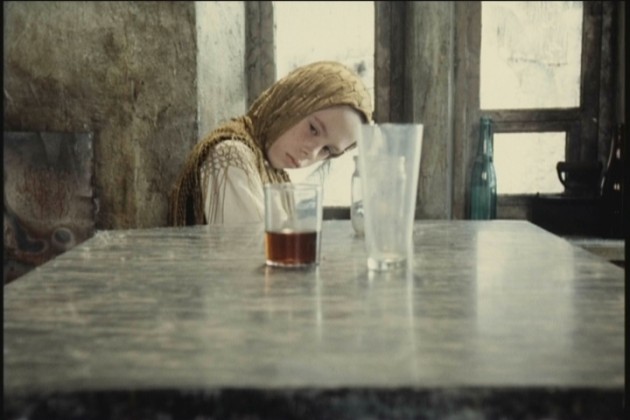
The order of events on both the sound and image tracks are crucial to keep in mind. In the bedroom scene at the beginning of the film, the order of events proceeds like this: 1) we hear the sound of the distant train whistle; 2) the sound of the vibrating nightstand emerges; 3) we see the glass vibrating on the nightstand before moving across it; 4) the sound of the train wheels on the tracks becomes apparent. In the film’s final shot, things progress differently: we hear the sound of the whistle, but then the first glass begins to move without the table shaking and without the liquid vibrating. We don’t hear or see the table vibrating until after the three glasses have moved across the table. Once the sound of the table vibrating emerges, we see the liquid in the glasses vibrating after which the sound of the train on its tracks becomes very loud.
The final shot clearly distinguishes between the movement of the glasses caused by the table vibrating, and movement caused by something else: apparently by the daughter’s gaze. However, as Donato Totaro suggests, the film maintains a measure of ambiguity about the cause of the first set of glass movements; perhaps it is possible that the distant train is vibrating the table imperceptibly resulting in the movement of the glasses (2001, 274). Indeed, to keep things interesting, the film does bring in the very faint sound of the train on the tracks as the first glass moves across the table, a connection that is absent when the glass starts vibrating on the nightstand during the bedroom scene. Yet the order of events in this final shot clearly subverts the way things operate in the bedroom scene, offering the possibility of interpreting the daughter’s gaze as being responsible for the movement of the glasses independent of the passing train.
So in this final shot we have another example of the stability of the offscreen world in relation to what we see on screen: by the end of the shot there is a clear connection between the vibrations of the table and the sound of the passing train, akin to what took place in the bedroom scene at the beginning of the film. At the same time, however, the final shot does something dramatically different: the daughter’s apparent power of telekinesis actually inverts the relationship between offscreen sound and onscreen movement. In fact, at one point a certain offscreen sound – the dog’s whimper – actually disrupts the movement of the glass as the daughter takes her eyes off of the glass for a moment to glance in the dog’s direction. When her gaze returns to the glass, the movement begins again. In presenting the world of Stalker’s home as a stable hi-fi environment, the film highlights the unusual nature of the daughter’s powers.
By initiating the movement of the glasses before the table begins to vibrate, she takes the place of the train sound as the logical cause of this movement. In so doing, she also removes the auditory cause of this movement and replaces it with a visual cause: the power of her gaze. So she connects the power of sound to the power of vision, and embodies the train’s thematic function of threading together the space of the Zone and the world beyond its borders. Essentially she is demonstrating the relationships between three different orders of perceptual awareness: subsonic vibration, sound, and vision. The nightstand at the beginning of the film and the table at the end both shake as the result of vibrations whose cause is revealed audibly afterwards. In this way, sound is revealed to be an extension of touch. Stalker’s daughter then brings this connection into the realm of vision, suggesting that the realm of the visual is also connected to touch. This is a transsensorial move, one that I suggest is born inside the space of the Zone. Just as she demonstrates how vision, hearing, and touch are all connected, she also illustrates how internal experience is connected to the outside. She creates a hi-fi environment between inside and outside, something the three men were afraid to open up within the Room. As such, Stalker’s daughter becomes an embodiment of the Room itself, destabilizing the divisions between the sense modalities as she demonstrates her internal connection to the outside world. Finally, I suggest that Stalker’s daughter also takes on the particular qualities of Tarkovsky’s camera as it functions within the Zone: an agent that brings the world into motion through its directed gaze. As I will illustrate in the second part of this essay, this quality of the camera’s presence within the Zone is tied to the audiovisual ecology of this space, an ecology that differs in many ways from the spaces of Stalker’s home and town.
Read part II here.
Works Cited
Bazin, André. 1971. “The Evolution of the Language of Cinema.” In What is Cinema?, translated by Hugh Gray, 23-40. Berkeley: University of California Press.
Berendt, Joachim-Ernst. 1987. The World is Sound: Nada Brahma: Music and the Landscape of Consciousness. Rochester: Destiny Books.
Chion, Michel. 1994. Audio-Vision: Sound on Screen, translated by Claudia Gorbman. New York: Columbia University Press.
Christie, Ian. 1981. “Against Interpretation: An Interview with Andrei Tarkovsky.” Framework 14 (Spring): 48-49.
Deleuze, Gilles. 1989. Cinema 2: The Time-Image, translated by Hugh Tomlinson and Robert Galeta. Minneapolis: University of Minnesota Press.
Leach, Jim. 1990. “Hideousness and Beauty.” In Before the Wall Came Down, edited by Graham Petrie and Ruth Dwyer, 203-213. Lanham: University Press of America.
Montagu, Ivor. 1973. “Man and Experience: Tarkovsky’s World.” Sight and Sound (Spring): 89-94.
Pasolini, Pier Paolo. 1988. Heretical Empiricism,, edited by Louise K Barnett, translated by Ben Lawton and Louise K. Barnett. Bloomington: Indiana UP.
Petric, Vlada. 1989/90. “Tarkovsky’s Dream Imagery.” Film Quarterly 43, no. 2. (Winter): 28-34.
Schafer, R. Murray. 1977. The Tuning of the World. Toronto: McLelland and Stewart.
Sterne, Jonathan. 2013. “Soundscape, Landscape, Escape.” Soundscapes of the Urban Past, edited by Karin Bijsterveld.
Thom, Randy. 2007. “The Acoustics of the Soul.” In “Sound in the Cinema and Beyond,” edited by Randolph Jordan. Special double issue, Offscreen 11, nos. 8/9 (August/September). PDF.
Totaro, Donato. 2001. Time and the Long Take in The Magnificent Ambersons, Ugetsu, and Stalker. PhD Dissertation. University of Warwick.
Truppin, Andrea. 1992. “And Then There Was Sound: The Films of Andrei Tarkovsky.” In Sound Theory, Sound Practice, edited by Rick Altman, 235-248. New York: Routledge.
Notes
- This essay is a lightly revised version of a chapter from my doctoral dissertation accessible in its entirety here. Read the introduction for stronger grounding in the sound theory to which I refer throughout this essay. ↩
- My analyses are grounded in several screenings of the film on 35mm that I’ve been lucky enough to attend, but I also rely heavily on home video releases of the film for the close reading I give the film here. Some controversy arose a few years back when the Russian Cinema Council (RusCiCo) released the film on DVD with a re-mixed 5.1 channel soundtrack that included a host of newly created material that never appeared in the original. It is no exaggeration to say that every single point I make about the sound in Stalker is disrupted by this new sound mix. For example, it is impossible to gauge the subtleties of the film’s use of environmental sound when an entirely new ambience full of continual wind, birds, water, and the like obscures Tarkovsky’s original treatments. What is more, the timing of certain sound effects has been adjusted so that the relationship between sound and camera movement is now different from the original. Even Edward Artemiev’s score has been “enhanced” with new instrumentation! Thankfully, RusCiCo later released a new edition of the film with the original soundtrack intact, keeping the re-mixed version as an alternate option. It is crucial to emphasize that I am working from DVD releases that use the original soundtrack, and readers should be aware of the need to check what version they have in case they choose to re-visit the film on DVD. ↩



